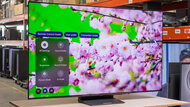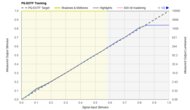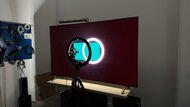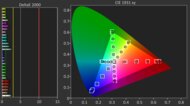Searching for the best gaming televisions will give you a ton of results, but it's easier to narrow down your options once you know what features to look for. Manufacturers have been working to enhance their TV gaming performance in recent years, aiming to compete with monitors. When evaluating a TV's suitability for gaming, certain criteria should be considered.
A TV's refresh rate is one of the most important factors since it's inherently tied to frame rate; if you want to game in 120 fps, you need a TV that supports a 120Hz refresh rate. A high refresh rate also goes hand-in-hand with VRR, as VRR lets the TV dynamically adjust its refresh rate to match the game's frame rate, minimizing, if not eliminating, any screen tearing that can result from the game's frame rate not matching the TV's refresh rate. Input lag is the time it takes for your controller inputs to register on screen, so it's one of the most important aspects for competitive gamers. Input lag is often confused with response time, but they're different. Response time is the time it takes for a pixel to change from one color to the next. TVs with slow response times leave blurry trails behind fast motion, while those with fast response times deliver clear motion. OLEDs are the uncontested best TVs in terms of response time, as their pixel transitions are nearly instantaneous.
The overall picture quality is also crucial for gaming. You want a TV that's bright enough to play games in a room with the lights on and not be distracted by reflections on your screen. Since many games are available in HDR, you also want a TV that displays a wide range of colors and has the contrast needed to provide deep enough blacks that highlights stand out against dark backgrounds. Through our rigorous testing procedure, we can determine if a TV's picture quality dips while using Game Mode and which TVs simultaneously provide excellent performance and image quality.
Below are our recommendations for the best overall gaming TVs available. If you're looking for an even bigger screen than a TV can give you, check out our picks for the best projectors for gaming. You can also check out our picks for the best 120Hz TVs, the best PS5 TVs, and the best TVs for Xbox Series X, or you can vote on which ones you want us to buy and test. To learn about all of the models on the market today, visit our 2025 TV lineup page.
Quick Look






We buy and test dozens of TVs yearly, taking an objective, data-driven approach to deliver results you can trust. Our testing process is complex, with hundreds of individual tests that take over a week to complete. Most of our tests are done with specially designed test patterns that mimic real content, but we also use the same sources you have at home to ensure our results match the real-world experience. We use two main tools for our testing: a Colorimetry Research CR-100 colorimeter and a CR-250 spectroradiometer.
-
Best Gaming TV
 Gaming9.3Mixed Usage8.9Home Theater9.0Bright Room8.8Sports8.8Brightness8.7Black Level10Color9.1Processing (In Development)8.3Game Mode Responsiveness9.4Resolution4kNative Refresh Rate165HzScreen FinishMatteTypeOLEDSub-TypeQD-OLEDSee all our test resultsDolby VisionNo
Gaming9.3Mixed Usage8.9Home Theater9.0Bright Room8.8Sports8.8Brightness8.7Black Level10Color9.1Processing (In Development)8.3Game Mode Responsiveness9.4Resolution4kNative Refresh Rate165HzScreen FinishMatteTypeOLEDSub-TypeQD-OLEDSee all our test resultsDolby VisionNoIf you want the best of the best with almost no compromises, the best gaming TV we've tested overall is the Samsung S95F OLED. Since it uses a QD-OLED panel, you get incredibly bright and vibrant colors that can't be matched by traditional WOLED displays. On top of that, highlights in HDR really pop out, so HDR games are incredibly immersive. A lot of OLED models don't fare well in bright rooms, but this TV is the only OLED on the market that features a matte screen coating. Reflections are almost invisible on this TV, so overhead lights and even direct light sources facing the screen are a non-issue. Like any OLED, you get unrivaled black levels, so blacks are deep and inky in a dark room. However, like all QD-OLEDs, blacks appear raised and have a slightly purple hue in a bright room. It even has a very wide viewing angle, so its image quality holds when viewed from an angle, making it a great choice for large living rooms.
The TV is also equipped with a ton of modern gaming features like four HDMI 2.1 ports, 4k @ 165Hz, and VRR, making it a great option for pairing with modern consoles and gaming PCs. It also has nearly instant pixel transitions, so motion is crisp and clear. Additionally, it features exceptionally low input lag for a responsive feel. It comes with Samsung's unique Slim One Connect Box, which gives you quick access to the inputs when the TV is wall-mounted and offers versatility for your setup. The only minor downside is that it doesn't support Dolby Vision for Xbox gamers, but since the vast majority of Xbox games don't natively support Dolby Vision and you really don't need it on a TV this good, it's not a big deal at all.
-
Best Upper Mid-Range Gaming TV
 Gaming9.1Mixed Usage8.6Home Theater8.8Bright Room7.6Sports8.1Brightness8.0Black Level10Color8.8Processing (In Development)8.4Game Mode Responsiveness9.4Resolution4kNative Refresh Rate144HzScreen FinishGlossyTypeOLEDSub-TypeQD-OLEDSee all our test resultsDolby VisionNo
Gaming9.1Mixed Usage8.6Home Theater8.8Bright Room7.6Sports8.1Brightness8.0Black Level10Color8.8Processing (In Development)8.4Game Mode Responsiveness9.4Resolution4kNative Refresh Rate144HzScreen FinishGlossyTypeOLEDSub-TypeQD-OLEDSee all our test resultsDolby VisionNoIf you don't want the Slim One Connect Box, 165Hz, a matte coating, or you just want to spend less, consider the Samsung S90F OLED. Like the Samsung S95F OLED, this model uses a QD-OLED panel in most sizes, so you still get the same perfect black levels and similarly vibrant colors. You also get impressive HDR brightness, so HDR games are impactful. Unfortunately, it's not nearly as bright in SDR as the more expensive Samsung, and its glossy screen coating doesn't provide nearly the same level of reflection handling, so reflections are visible in a bright room. However, these aspects are still good enough that you can use the TV in a moderately lit room, and you aren't distracted by reflections. You also get the same wide viewing angle as the more expensive model, making it great for accommodating wide seating arrangements.
Despite not offering 165Hz support, you can still game in up to 4k @ 144Hz with VRR on any of its four HDMI 2.1 ports. The TV has the same nearly instant pixel transitions and low input lag, so you get a sharp and smooth gaming experience. If you're considering this TV, just keep in mind that only some sizes have a QD-OLED panel, and even that varies by region.
-
Best Mid-Range Gaming TV
 Gaming8.5Mixed Usage8.2Home Theater8.4Bright Room6.7Sports7.1Brightness7.0Black Level10Color8.3Processing (In Development)8.3Game Mode Responsiveness9.0Resolution4kNative Refresh Rate120HzScreen FinishGlossyTypeOLEDSub-TypeWOLEDSee all our test resultsDolby VisionYes
Gaming8.5Mixed Usage8.2Home Theater8.4Bright Room6.7Sports7.1Brightness7.0Black Level10Color8.3Processing (In Development)8.3Game Mode Responsiveness9.0Resolution4kNative Refresh Rate120HzScreen FinishGlossyTypeOLEDSub-TypeWOLEDSee all our test resultsDolby VisionYesThe LG B5 OLED is the best OLED TV for gaming in the mid-range category that we've tested. It's truly an awesome TV, with only a few drawbacks compared to the more expensive Samsung S90F OLED. It has most of the same features as the Samsung, although this LG model doesn't support 144Hz and is dimmer in HDR overall. Still, it's bright enough for highlights to stand out in HDR, and it's just bright enough in SDR to overcome glare in a room with a few overhead lights on. Like any OLED, you get inky blacks that are sure to impress. One advantage this WOLED has over the QD-OLEDs above is that blacks don't have a purple tint in a bright room, which is great if you regularly game in a room with your lights on. Colors aren't as vivid as they are on the two Samsung QD-OLEDs, but they still look vibrant and punchy enough to please most people.
If you play couch co-op games with friends, this TV's wide viewing angle means anyone seated to the sides of the screen doesn't see a degraded image, so there's no fighting for the best seat in the house. This model isn't light on gaming features, as its four HDMI 2.1 bandwidth ports offer up to 4k @ 120Hz gaming with VRR. It also has a nearly instantaneous response time and extremely low input lag. Unlike the Samsung models, this TV supports Dolby Vision for Xbox gamers who like to play in that specific HDR format. Overall, this TV is a great entry point into the OLED market.
-
Best Lower Mid-Range Gaming TV
 Gaming7.8Mixed Usage7.8Home Theater7.9Bright Room8.0Sports7.9Brightness7.8Black Level8.4Color7.5Processing (In Development)7.7Game Mode Responsiveness8.0Resolution4kNative Refresh Rate144HzScreen FinishGlossyTypeLEDSub-TypeVASee all our test resultsDolby VisionYes
Gaming7.8Mixed Usage7.8Home Theater7.9Bright Room8.0Sports7.9Brightness7.8Black Level8.4Color7.5Processing (In Development)7.7Game Mode Responsiveness8.0Resolution4kNative Refresh Rate144HzScreen FinishGlossyTypeLEDSub-TypeVASee all our test resultsDolby VisionYesIf you can't afford an OLED or simply don't want one, you can still get a solid gaming experience from a Mini LED TV like the TCL QM7K. You don't get the same perfect black levels of an OLED, but this model has great local dimming, so blacks are very deep with only some minor haloing around highlights. Colors are punchy, and highlights stand out well in HDR, so this TV provides excellent image quality in your favorite HDR games. This is a very bright TV with excellent reflection handling, allowing you to use it in a room with bright overhead lights without worrying about reflections on the screen. It has a relatively narrow viewing angle, which is fine if you have friends seated at a slight angle to the screen, but it's not wide enough to retain its image quality from more aggressive angles.
It supports a ton of gaming features that will please console and PC gamers alike. It supports 4k @ 144Hz and 1080p @ 288Hz, so you have options when it comes to the resolution and refresh rate you want to game in. You don't get the same nearly instantaneous pixel transitions as the OLEDs above, but they're pretty quick for a Mini LED model, so fast motion only has some minor trails of blur behind it. You enjoy a tear-free gaming experience thanks to its VRR support. Furthermore, the TV offers a snappy gaming experience thanks to its low input lag, especially at high refresh rates, so you're not at a disadvantage in PVP shooters.
-
Best Budget Gaming TV
 Gaming7.2Mixed Usage7.1Home Theater7.2Bright Room7.0Sports7.1Brightness6.5Black Level7.6Color7.2Processing (In Development)7.0Game Mode Responsiveness7.9Resolution4kNative Refresh Rate144HzScreen FinishGlossyTypeLEDSub-TypeVASee all our test resultsDolby VisionYes
Gaming7.2Mixed Usage7.1Home Theater7.2Bright Room7.0Sports7.1Brightness6.5Black Level7.6Color7.2Processing (In Development)7.0Game Mode Responsiveness7.9Resolution4kNative Refresh Rate144HzScreen FinishGlossyTypeLEDSub-TypeVASee all our test resultsDolby VisionYesIf the TCL QM7K is a bit out of your price range, you don't lose a ton by going with the TCL QM6K instead. Blacks aren't as deep as they are on the more expensive model, but its contrast ratio is still good enough for bold blacks in a dark room. Colors appear slightly muted compared to the QM7K, but they remain vibrant enough to please most gamers. The TV has good SDR brightness, which helps overcome glare from indirect sources, such as overhead lights. Unfortunately, the TV's HDR is a bit too dim for highlights to truly pop, so HDR games appear somewhat underwhelming. Like the QM7K, its viewing angle is narrow, so you might want to look elsewhere if you have a large living room with seating off to the sides of the screen.
Fortunately, the TV's gaming performance is nearly on par with that of the more expensive TCL. Pixel transitions are almost as quick, input lag is low, and the TV supports VRR. It even supports 4k @ 144Hz and 1080p @ 288Hz on its two HDMI 2.1 ports, so it's a versatile model.
-
Best Cheap Gaming TV
 Gaming6.2Mixed Usage6.0Home Theater5.8Bright Room6.3Sports6.0Brightness5.6Black Level4.9Color6.8Processing (In Development)6.3Game Mode Responsiveness6.7Resolution4kNative Refresh Rate60HzScreen FinishGlossyTypeLEDSub-TypeVASee all our test resultsDolby VisionYes
Gaming6.2Mixed Usage6.0Home Theater5.8Bright Room6.3Sports6.0Brightness5.6Black Level4.9Color6.8Processing (In Development)6.3Game Mode Responsiveness6.7Resolution4kNative Refresh Rate60HzScreen FinishGlossyTypeLEDSub-TypeVASee all our test resultsDolby VisionYesIf you don't have a lot of money to spend and just need something that gets the job done, the Hisense QD6QF is a decent choice. You won't find many modern gaming features on this model, but it still supports VRR to reduce screen tearing. The TV offers a 1440p @ 120Hz mode for those who prefer frames over resolution, but input lag is unusually high when you do that, so most people are best off sticking to 4k @ 60Hz. Pixel response times are a bit on the slower side, so fast motion is noticeably blurry, but it's not too bad for a cheap model. If you're an Xbox gamer, this model supports Dolby Vision, allowing you to play games in this HDR format.
In terms of picture quality, the TV is unremarkable. This is the only LED TV on our list that doesn't have local dimming, so blacks appear grayish, resulting in an image that looks somewhat flat. The TV can't display very bright colors or very dark ones, but since the TV still displays a wide range of colors, games don't look too muted. Unfortunately, it's too dim in HDR for highlights to truly stand out, so HDR gaming is lackluster. The TV is just bright enough to use in a room with a few overhead lights on, and you may not be distracted by reflections, but visibility is an issue in bright rooms.
Notable Mentions
-
LG G5 OLED:
The LG G5 OLED is one of the best TVs on the market and shares many of the same features as the Samsung S95F OLED, like 165Hz.
It has very impressive colors, but it still doesn't match the level of vividness you get from a QD-OLED TV like the Samsung. Even though the LG is a bit brighter, it doesn't do as good a job reducing the intensity of reflections, making the Samsung the slightly better gaming TV overall.
See our review -
LG C5 OLED:
The LG C5 OLED is an alternative to the Samsung S90F OLED. It's brighter than the Samsung in SDR and does a better job retaining its black levels in a bright room. However, the Samsung is brighter in its dedicated gaming mode, and it displays more vivid colors, making it the better TV for most gamers.
See our review -
TCL QM8K:
The TCL QM8K is a great alternative to the LG B5 OLED if you mostly play games in a bright room. The TCL is significantly brighter than the LG, so it easily overcomes glare in almost any bright room. However, you don't get the inky blacks OLEDs are known for, although they're still very deep. You also don't get the same crystal clear motion as you do on the LG, but it's pretty good for an LED TV, so motion isn't too blurry.
See our review -
Hisense U75QG:
The Hisense U75QG is a good option if you wish the TCL QM7K was brighter. However, the Hisense drastically overbrightens HDR content, so it doesn't stay true to the game maker's intent. The Hisense also
has slow pixel transitions, so fast motion is noticeably blurrier on it. Since the TCL also has superior contrast, it's the more complete package overall.
See our review -
Hisense U65QF:
The Hisense U65QF is comparable to the TCL QM6K, but it's noticeably brighter. Unfortunately, the Hisense displays HDR content much brighter than intended. Since the TCL has better black levels, superior accuracy, supports 1080p @ 288Hz, and has lower input lag, it's the better option for most gamers.
See our review -
TCL S551G:
The TCL S551G is an alternative to the Hisense QD6QF. The Hisense offers superior image quality, making it the better option for most people. However, the 120Hz mode that the TCL offers has much lower input lag than the Hisense, so it's a good option for gamers on a budget who prefer performance over image quality.
See our review
Recent Updates
Dec 16, 2025:
We confirmed the accuracy and availability of our picks.
Oct 30, 2025:
We replaced the LG B4 OLED with the LG B5 OLED in the 'Best Mid-Range' category, and replaced the TCL Q651G with the Hisense QD6QF in the 'Best Cheap' category. We also updated the Notable Mentions section.
Jul 15, 2025:
We replaced the Samsung S90D OLED with the Samsung S95F OLED as our new top pick. We also replaced the LG C4 OLED with the Samsung S90F OLED in the 'Upper Mid-Range' category, the Hisense U7N with the TCL QM7K in the 'Lower Mid-Range' category, the Hisense U6N with the TCL QM6K in the 'Budget' category, and the Hisense A7N with the TCL Q651G in the 'Best Cheap TV' category. We also dropped the 'Best Bright Room' category, since the S95F outperforms our old pick, the Sony BRAVIA 9.
May 13, 2025:
We dropped the TCL QM7/QM751G QLED from the Notable Mentions and mentioned it alongside the Hisense U7N instead. We also touched on the issues facing the 77-inch Samsung S90D OLED, added the Samsung S95D OLED to the Notable Mentions, mentioned the LG C5 OLED alongside the LG C4 OLED, and replaced the Sony A95L OLED with the LG G5 OLED in the Notable Mentions
Jan 29, 2025:
Added a link to our 2025 TV Lineup page and updated some text throughout the article for accuracy.
All Reviews
Our recommendations are based on what we think is the best 4k TV for gaming, depending on your budget and needs. They are adapted to be valid for most people in each price range. The rating is based on our review, factoring in price and feedback from our visitors.
If you would prefer to make your own decision, here is the list of all of our TV reviews. Be careful not to get too caught up in the details. Most TVs are good enough to please most people, and the things we fault TVs on are often not noticeable unless you really look for them. Also, keep in mind that our scores aren't comparable across different test benches, so most of the older TVs in the list below score higher than they would today.



















